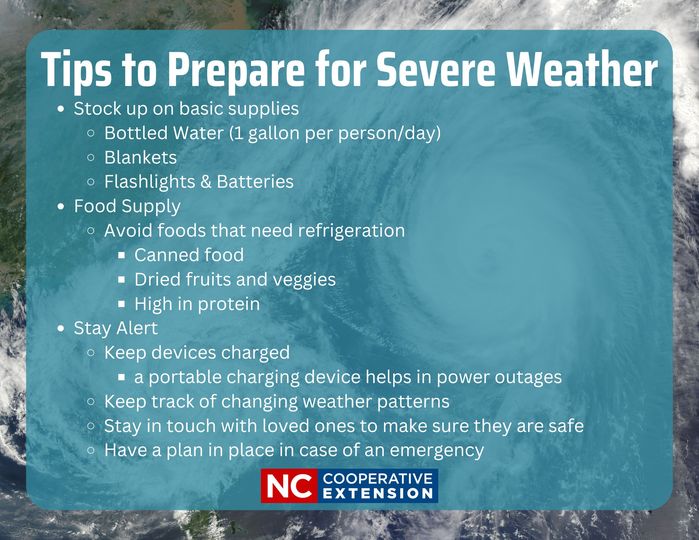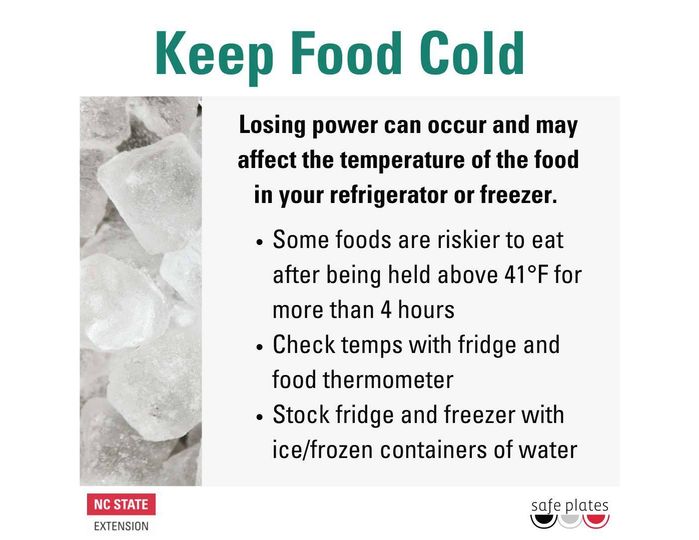Preparing for Weather Disasters
go.ncsu.edu/readext?1029508
en Español / em Português
El inglés es el idioma de control de esta página. En la medida en que haya algún conflicto entre la traducción al inglés y la traducción, el inglés prevalece.
Al hacer clic en el enlace de traducción se activa un servicio de traducción gratuito para convertir la página al español. Al igual que con cualquier traducción por Internet, la conversión no es sensible al contexto y puede que no traduzca el texto en su significado original. NC State Extension no garantiza la exactitud del texto traducido. Por favor, tenga en cuenta que algunas aplicaciones y/o servicios pueden no funcionar como se espera cuando se traducen.
Português
Inglês é o idioma de controle desta página. Na medida que haja algum conflito entre o texto original em Inglês e a tradução, o Inglês prevalece.
Ao clicar no link de tradução, um serviço gratuito de tradução será ativado para converter a página para o Português. Como em qualquer tradução pela internet, a conversão não é sensivel ao contexto e pode não ocorrer a tradução para o significado orginal. O serviço de Extensão da Carolina do Norte (NC State Extension) não garante a exatidão do texto traduzido. Por favor, observe que algumas funções ou serviços podem não funcionar como esperado após a tradução.
English
English is the controlling language of this page. To the extent there is any conflict between the English text and the translation, English controls.
Clicking on the translation link activates a free translation service to convert the page to Spanish. As with any Internet translation, the conversion is not context-sensitive and may not translate the text to its original meaning. NC State Extension does not guarantee the accuracy of the translated text. Please note that some applications and/or services may not function as expected when translated.
Collapse ▲ The best way to survive a disaster and be able to quickly recover is to be prepared. There are a number of things that you can do to help prepare you and your family for a disaster.
The best way to survive a disaster and be able to quickly recover is to be prepared. There are a number of things that you can do to help prepare you and your family for a disaster.
Hurricanes, tornadoes, floods, ice storms and other natural disasters can cause power outages or water damage that can put refrigerated, frozen and dry foods at risk. From power outages to flooding, the impacts can pose significant challenges to everyday life.
Preparing an emergency kit for your family is one way to be prepared. The time to put an emergency kit together is before a disaster.
An emergency kit is a container of items your family may need in or after an emergency. Most of the items can be found in your house. It is important to put them in one place. Be sure every family member knows where the kit is kept.
Some suggestions for your kit could be:
- Water – 1 gallon per person and pet per day for 3 to 7 days
- Food – Non-perishable and canned food supply for 3 to 7 days
- Battery-powered or hand crank radios with extra batteries
- First aid kit
- Flashlight and extra batteries
- Manual can opener for food
- Wrench or pliers to turn off water
- Prescription medication and glasses
- Personal hygiene supplies
- Books, games or cards
You may be on your own for hours or even days after a disaster. Being ready for an emergency helps you and your family to survive. It also allows police, fire fighters and emergency medical workers to help those who need it most.
Preparing for a Power Outage
1. Purchase or locate thermometers. Place a thermometer in your refrigerator and freezer; have a tip-sensitive digital thermometer ready to check food temperatures. Foods that can support the growth of pathogens (like cooked vegetables, cooked and raw meats and cut melons, leafy greens and tomatoes) are riskier after being held above 41F for more than 4hrs.
3. Store or purchase water in case case water systems are impacted resulting in boil water advisories. Use bottled/clean water for everything from brushing teeth, cooking.
- Prepare for keeping your food safe during loss of power
- Keep doors closed as much as possible on your refrigerator and freezers. Here is a chart to know what is safe to keep and what needs to be discarded





